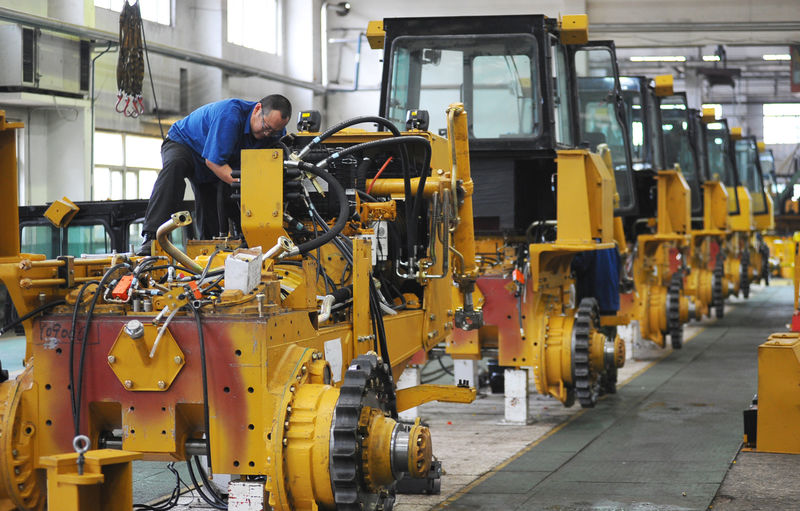By Elias Glenn
BEIJING (Reuters) - Growth in China's manufacturing sector cooled more than expected in October in the face of tighter pollution rules that are forcing many steel mills, smelters and factories to curtail production over the winter.
While still easily in expansionary territory, China's monthly official factory survey also showed unexpected weakness in new export orders, which had been expected to pick up heading into the peak year-end shopping season.
The data gives global investors their first look at business conditions in China at the start of the fourth quarter, with the government's punishing war on smog adding to uncertainty amid early signs of a slowdown in the world's second-largest economy.
"Some regions stepped up pollution controls this month, with firms adjusting, halting or staggering production," National Statistics Bureau official Zhao Qinghe said in comments published with the data.
Zhao said that activity in energy-intensive and polluting industries slowed in October, while high-end manufacturing and consumption-related manufacturing continued to grow.
The official Purchasing Managers' Index (PMI) released on Tuesday fell to 51.6 in October, from 52.4 in September, which was the strongest in over five years.
It was the weakest reading in three months, but remained above the 50-point mark that separates growth from contraction on a monthly basis.
Analysts surveyed by Reuters had forecast the PMI would fall slightly to 52.0, but still point to the 15th straight month of expansion.
China's economy has recorded better-than-expected growth of nearly 6.9 percent through the first nine months of this year, buoyed largely by a recovery in its manufacturing and industrial sectors thanks to strong government infrastructure spending, a resilient property market and unexpected strength in exports.
Profits for the country's industrial powerhouses surged 27.7 percent in September, the most in nearly six years, as environmental inspections and the start of plant closures in smog-blighted northern provinces sparked fears of supply shortages and sent prices of finished goods like steel and copper sharply higher.
However, the latest survey showed input price gains slowed considerably in October, with the reading at 63.4 compared to 68.4 in September and the weakest since July.
A separate PMI for the steel industry showed raw material purchase prices fell sharply in October after strong gains in recent months.
Output price gains also slowed, reflecting concerns that higher commodity prices have not trickled down to higher prices and profit margins for downstream industries.
Prices of steelmaking raw materials such as iron ore and coking coal have started to dive on fears that winter output curbs will lead to a supply glut, weighing on mining companies and global commodity prices. [IRONORE/]
More rigorous restrictions on steel output are expected in November as manufacturers in 28 cities in northern China have been asked to stagger production to reduce emissions.
THE COST OF BLUE SKIES
The latest pollution closures come on top of ongoing government efforts to trim down and upgrade China's bloated industrial sector by shutting down outdated capacity, which has also helped support producer prices.
The PMI decline was "likely due to disruptions to industrial activity in north-eastern China as a result of the ongoing environmental crackdown, as well as softer investment spending in response to slower credit growth and the unwinding of pre-Party Congress fiscal support," said Capital Economics China economist Julian Evans-Pritchard.
"We anticipate further weakness in the months ahead."
A sub-reading for output fell to 53.4 in October from 54.7 the previous month, still solid but matching the slowest growth over the last seven months.
At China's recently-concluded Communist Party Congress, President Xi Jinping said the country would pursue high-quality growth over high-speed growth while reinforcing a pledge to win the war on pollution and clamp down on riskier types of lending.
But analysts are unsure if the government would stomach the risk of markedly slower economic growth rates without resorting to fresh stimulus measures, as authorities have done in the past.
COOLING DEMAND
The official survey pointed to cooling demand at home and abroad. Export order growth nearly stalled, and was the weakest since December, while imports also slowed, though they remained in expansionary territory.
Large firms, many state-owned, continued to outperform at the expense of small and mid-sized firms, with medium-sized companies backsliding the most in October.
"The lower PMI implies some weakening in (economic) growth momentum in October after a strong September," economists at Nomura said in a note. "We maintain our forecast of real GDP growth slowing further to 6.6 percent year-on-year in Q4 from 6.8 percent in Q3."
Growth in China's services sector also eased in October, but continued to show solid expansion, a sister survey showed, suggesting it may offset much of the downdraft from the loss of steam in manufacturing.
The official non-manufacturing Purchasing Managers' Index (PMI) fell to 54.3 from 55.4 in September, which was the strongest reading since May 2014.
A sub-reading for the construction sector fell to 58.5 from 61.1 in September.
The services sector accounts for over half of China's economy, with rising wages giving Chinese consumers more spending power.
The employment situation in both the manufacturing and services industries worsened in October, with firms across the economy shedding staff at a faster rate, the data showed.
